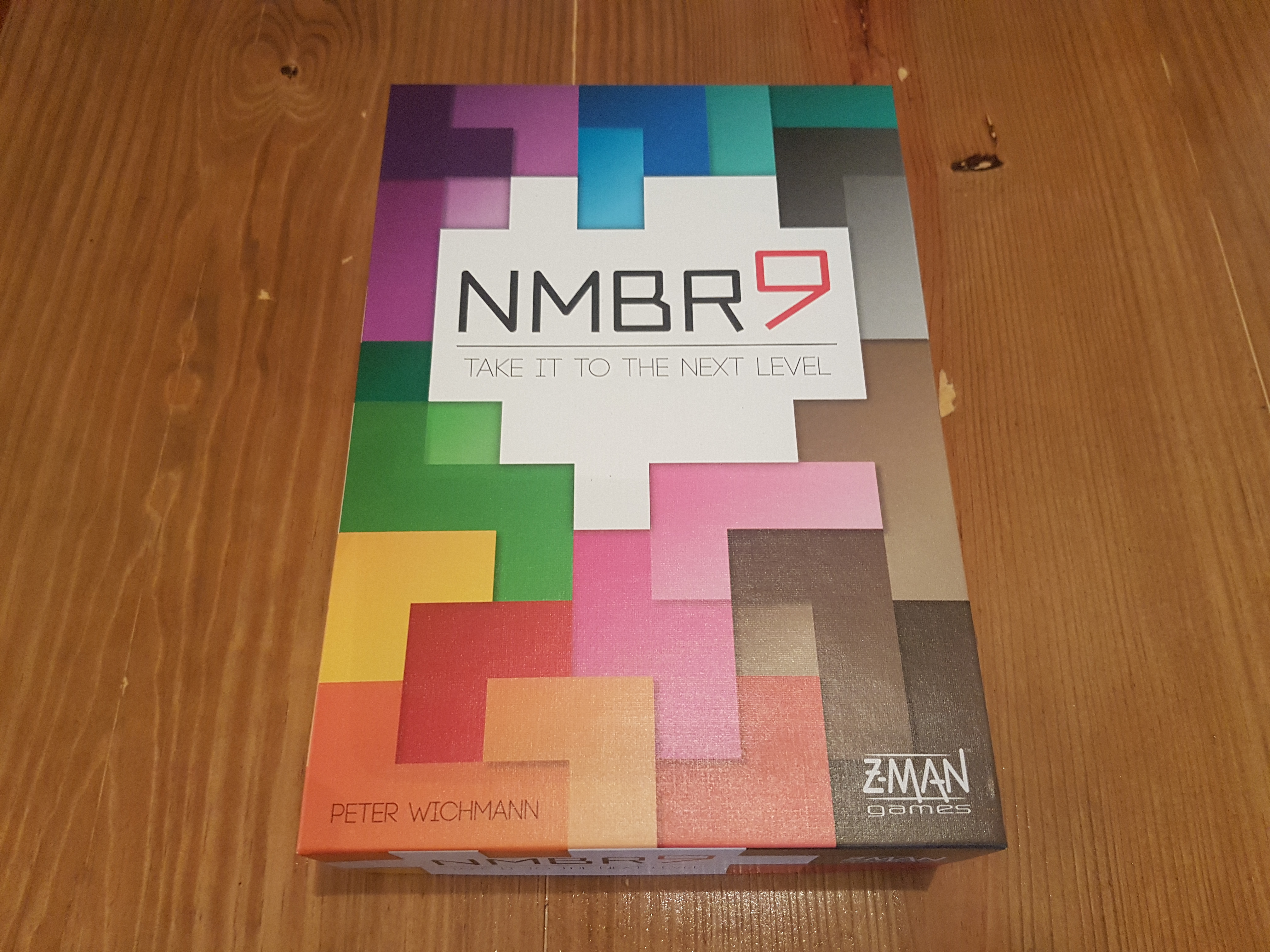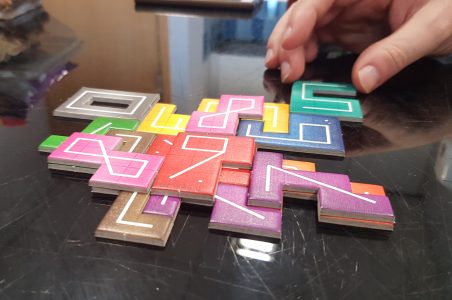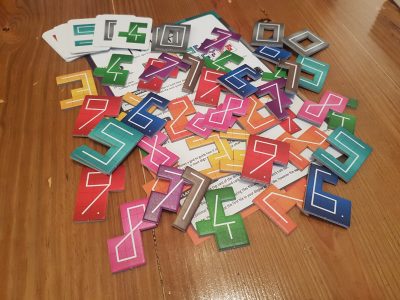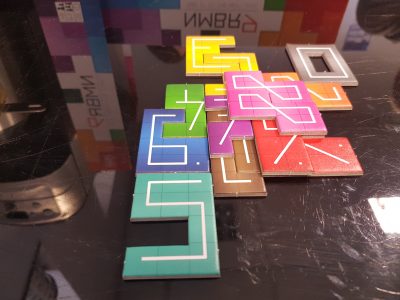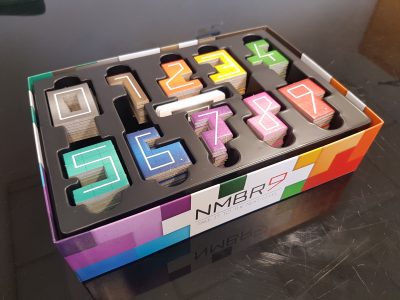NMBR 9 is a puzzle style tile laying game, from designer Peter Wichmann. Players will simultaneously be trying to complete the same puzzle better than the others around the table. The tiles are numbered 0 – 9 and in a game each number will feature twice, totalling 20 number tiles. Can you beat your friends and show them how it’s really done? Well, first let’s find out how to play!
It is not often that setup of a game can be commended to such lengths. NMBR 9 is almost ready to go straight off the shelf. Take the lid off the box, shuffle the 20 number cards, place the pile face down and the game is ready to be played. It is that simple! Designate one player to be the card turner and each turn they flip over the top number card. Each player then gets a tile shaped like this number, made up of squares, which they must place on their own display. The first tile to be placed can be in any rotation: after this tiles must be placed touching at least one of the squares, that the tiles are made of, of an already placed tile.
Once more than two tiles are on a players display they could potentially start building on level 1 (layer 2 of the display). To place a number onto level 1 and subsequent levels above the tile must again touch one square of any other number on that level (if there are any), cover at least two numbers on the level below and be completely supported. So, leaving gaps and holes when building the base layer (level 0) can make your life tricky later on.
But why do you want to build upwards, not outwards? The base level that everyone starts building on is level 0, the one above is level 1, then level 2 and so on. A number tile scores points for the number it is multiplied by its level. Therefore, a 9 on level 0 scores absolutely nothing, wasting a big number! This creates an interesting mentality difference between players where some will strive to only put the big numbers on levels above 0. Others will be happy to burn a big number for later gains by building a solid base.
After all the numbers are played the puzzle is over and points are calculated. You’ll either turn to mental maths as you deconstruct your display of tiles or (like most) will just pull up a calculator app on a phone. Either way, the player(s) with the most points wins. There is a potential for a rather large anti-climax end to NMBR 9 if the last number turns out to be a 0. This does not happen often though but when it does it somehow feels like the game has been massively cut short, despite only being a scoring number out.
If you love player interaction then NMBR 9 may not be for you. There is zero interaction between players than extend further than cheeky glances at what others are doing and exchanges about where pieces have been put. This is fine for the most part as this is really a puzzle in game form. I am left wondering “what if” there were variants. Similar to the way Junk Art plays there could be other game modes with team play or a huge one pile variant with scoring in real time when placed.
This works in Junk Art to take the normal gameplay and spice it up in different ways and something similar could have taken NMBR 9 to the next level. Without this variation the title still won’t stay on the shelf collecting dust, it will still get its fair share of playtime. Alas, variation could have allowed it to stay on the table longer and also be played with gamers after differing experiences.
Have you beaten the puzzle better than the others around the table? Throughout the game there is a certain sense of mystery to how others are doing. The tiles placed are on show so you are able to calculate current points, if you so wish. The mystery element is how they are able to use the future numbers with what is already on the table. There are different approaches and they all seems to have some success. New players do seem to go down the route of a gap free base layer to make level 1 a bit easier to score from. Others will go for a build-upwards asap; but I have found this only puts you at the mercy of the future numbers.
As simple as setup is, playing the game is for the most part is simple. This simplicity continues over to the scoring which is incredibly clear and intuitive. The tile is shaped like the number so there isn’t any awkwardness when working out what it’s worth, or checking the rulebook for what a symbol means. The only rule that seems to occasionally slip up is placement on level 1 or higher. New players to the game can forget that tiles on this layer must also touch by a square and not just fit above gap free sections of the level below. A slight leniency in game one will get you through this and get them up to speed with how the puzzle plays out.
The game box and the tiles themselves are larger than I anticipated. I’ll take the hit on the shelf space though, as it makes the tiles that bit nicer to handle. When placing the tiles points earnt are all you need to worry about as they aren’t fiddly, instead being decently thick and large. On top of this the box insert keeps all the numbers nicely sorted and separate, hence the short setup time.
The game length is short, around 15-20 minutes depending on the levels of analysis. Therefore, it is easy to get NMBR 9 to the table and certainly doesn’t outstay its welcome. Many people look for a game they could play at a lunch at work, NMBR 9 could well be that game. It uses very little room in front of each player and within an hour you can comfortably fit 2/3 games in and have plenty of time to eat, chat and surf the internet. This also means it is a swift filler game, for when players want to just have a quick puzzle between larger, weightier games.
This is a puzzle which changes every time you play by simply shuffling the cards. You will sometimes fall back onto known tile placements if the tiles come up in a particular order but mostly the numbers come out different each time. The game can be played solitaire, however because of the shuffling NMBR 9 is not built to be equal from game to game. Effectively you will just be trying to get the best score possible that game. What you aren’t able to properly do is compare that score to one from another game.
Effectively, the shuffling changes the order of the cards and therefore the amount of possible points. You could try to continually go through the same order of cards to get the best score but subsequent turns when you know what order the numbers will come up in would have an obvious advantage. As a result of the different approaches I prefer to play NMBR 9 with the full player count of 4, but it really doesn’t matter. Whatever works for you, as it often always feels like your building your own puzzle answer separately anyway.
NMBR 9 just about squeezes in as board game but truly it should be referred to as a puzzle. An enjoyable puzzle which does give players that head scratching feels. The lack of interaction drives this difference and I would love to see a variant that added in some kind of interaction, whether it was “take that” styled interactions or a communal build. The fact the game is short in length, from getting the box to the table to the end of scoring, will see NMBR 9 hitting the table above other fillers. Especially as it just offers a very different experience, no matter the player count.
[Editor’s Note: NMBR 9 was provided to us by Esdevium Games for review purposes. The game is currently available on 365 Games for £24.99. It is also available from local UK board game stores, find your local store here]

